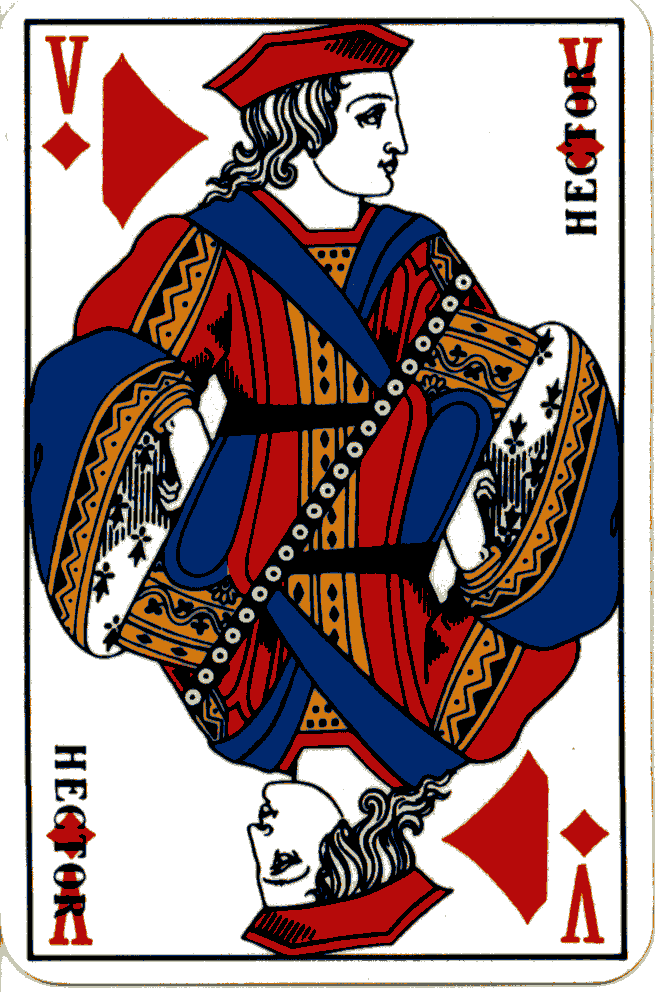I'm going to see my parents for Memorial Day weekend, and it is very likely that we will play cards during my visit. Which got me thinking about cards, and wondering where they came from.
- The earliest playing cards are believed to have appeared in the 10th century, when the Chinese made dominoes out of paper and then made up new games with the shufflable dominoes. They had at least two suits, of bamboo sticks and circles, which are also used in Mah-Jong tiles.
- The next incarnation was in the Moslem world, especially near Egypt, when cups and swords were added to make four suits, and court cards were also added.
- The Europeans started importing cards in the late 1300's. At that time, cards were hand-painted, very expensive, and only the very wealthy could afford them. Somehow, though, the less enfranchised managed to get hold of playing cards as well, and their popularity spread. Soon, the process of printing using wood cuts was invented, and more cards were produced more quickly.
- The French were really the ones to change cards essentially to the way we recognize them today. While other countries had complex insignia for the four suits, the French's spades, clubs, diamonds, and hearts were simple shapes in single colors and easier to make. The English imported these cards like mad, and then they found their way to the colonies in America.
- To this day, playing cards in other countries in Europe retain some differences. For example, playing cards in Italy, Spain, Germany, and Switzerland have no queens. In Switzerland, the Deuce or Daus is the top card which has the letter "A" on it, as if it were an ace.
- In the 1800's, Americans began making cards of their own. Innovations included giving the court cards two heads, so that you didn't have to rotate the cards one particular way, varnishing the surfaces to make them slipperier for shuffling and longer-lasting, and rounding the corners which also helped them last longer and avoid tell-tale creases.
- Americans also invented the Joker. It was originally inscribed as the Best Bower (most powerful) card in Euchre. Euchre was sometimes called "Juker," and it is likely that the Best Bower card was also called the Juker card, which then evolved into the "Joker." By the 1880's, people were using a picture of a court jester or clown for the Joker card, as a way to add it to the court cards without upsetting the royal hierarchy, so to speak.
- Right about the time that cards were starting to get standardized, people made the court cards to represent actual monarchs. In some games, people actually referred to the cards by name:
- King of Spades: King David (Biblical)
- King of Diamonds: Julius Caesar
- King of Clubs: Alexander the Great
- King of Hearts: Charlemagne
- Queen of Spades: Pallas Athena (Greek)
- Queen of Diamonds: Rachel (Biblical)
- Queen of Clubs: called Argine, anagram for regina ("queen")
- Queen of Hearts: Judith, either from the Bible, or Charlemagne's daughter-in-law, Judith of Bavaria
- Jack of Spades: Hogier the Dane, one of Charlemagne's paladins, from the Song of Roland
- Jack of Diamonds: Hector of Troy, or sometimes Roland of France
- Jack of Clubs: Sir Lancelot
- Jack of Hearts: French warrior and companion to Joan of Arc, named Etienne de Vignoles, a.k.a. La Hire


Images of cards from D.J. McAdam's and David Madore's sites
Sources
United States Playing Card Company, A Brief History of Playing Cards
The International Playing-Card Society, History of Playing Cards
The World of Playing Cards
Nancy R. Fenn, "The Four Great Kings in the Card Deck,"Be My Astrologer
D.J. McAdam, The People on the Playing Cards
Andy's Playing Cards, The National Patterns
David Madore's site, Courts on Playing Cards
The third image is interesting - where can I get that card design?
ReplyDeleteOops. Sorry about that.
ReplyDelete